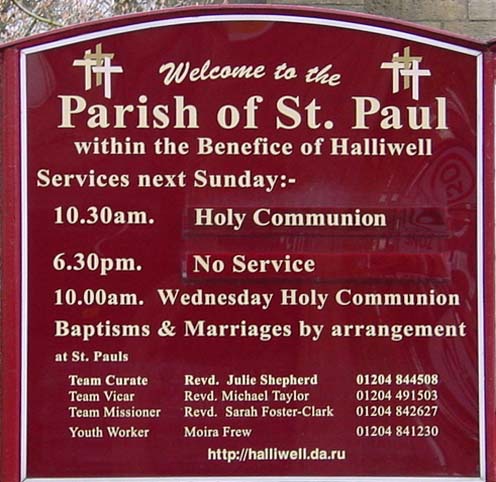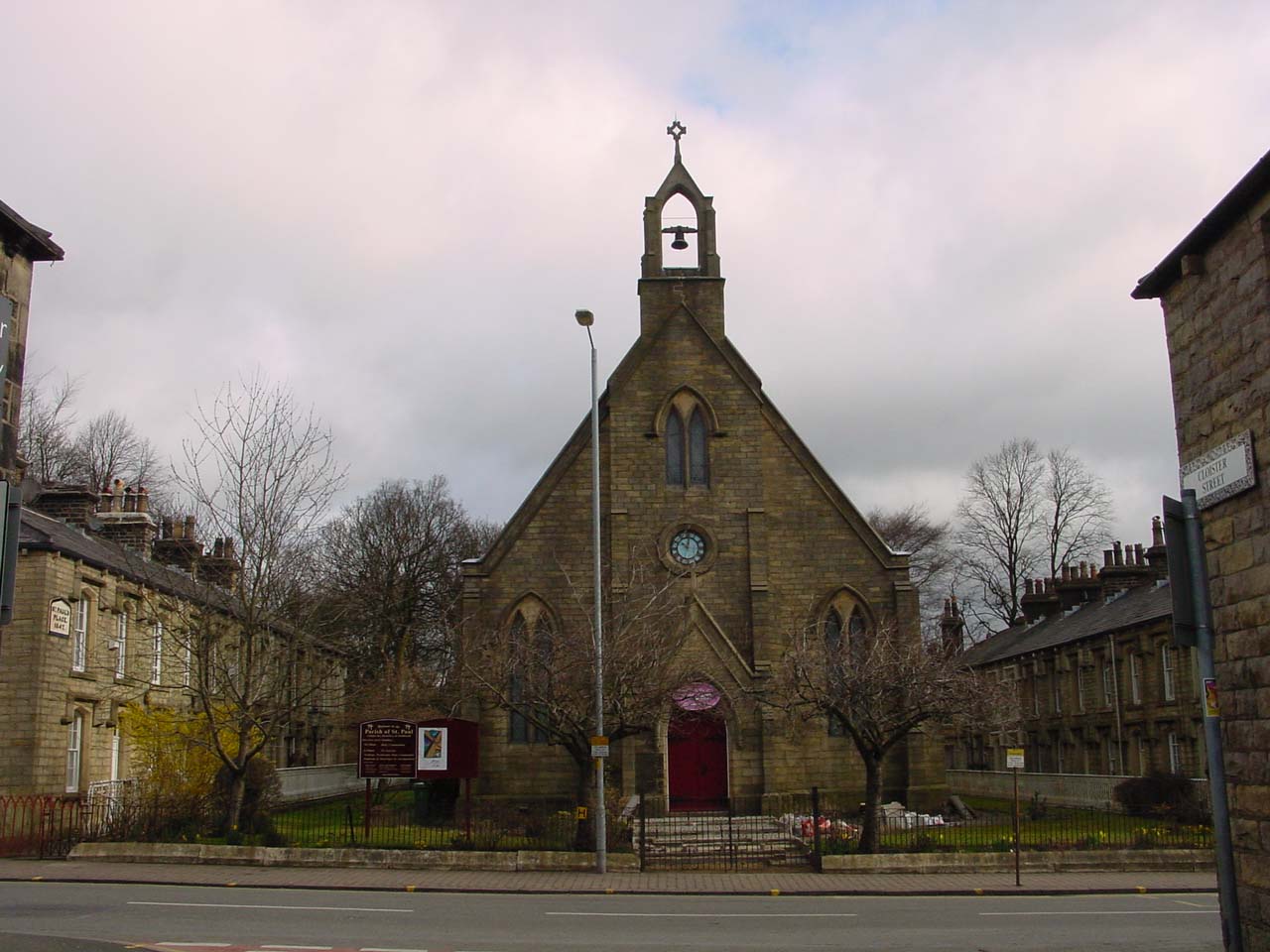 |
The Church of St Paul, Halliwell |
 |
 | |
 | |
From The Bolton Journal and Guardian, Friday, June 11, 1937, reproduced here by the kind permission of the Bolton News.
In many places in Smithills one may come across the initials of members of the Ainsworth family – on farm buildings or on the wall of a bleachworks. The Ainsworth family has had, in fact, a tremendous influence on this part of Bolton.
A previous article in this series has shown that the generosity of Mr. J.H. Ainsworth was responsible for the erection of St.Peter’s Church, Halliwell, and the Ainsworths were ever a devout family.
When they first came here, Halliwell must have been a very small community in spite of the fact that the township covered a much wider area than the district we know as Halliwell does today. There was a toll-bar on Halliwell-rd., close to where the Lamb Inn now stands, and beyond that was little else but fields.
The coming of the Ainsworths to set up their bleachworks at Halliwell made a difference, but the complexion of Halliwell was not greatly changed, and it long remained a rural spot. A “Journal and Guardian” representative found this week that many of the older residents in Halliwell could recall the days when Halliwell was very much of a village and almost completely cut off from Bolton. A century ago it must have been just a pleasant country spot, just a hamlet – with a few houses at that – with farms stretching away on every side.
Mr. J.H. Ainsworth, of Moss Bank, took a deep interest in the village, and being a notably spiritual-minded man, it occurred to him that the village which had sprung up on this (Halliwell) side of the district, lacked one important thing – a church. St Peter’s (now known as Smithills Church) had been built in 1840, at his sole expense.
The story goes that he had been on a visit to the south of England, and there saw a church around which had been built a group of houses forming a little hamlet. He was very much impressed with what he saw and on his return decided to carry out the same idea at Halliwell. The result was the erection, in 1847, of St. Paul’s Church with St. Paul’s-place running parallel with the church on either side of it. Church, school and houses are all of the same date, and doubtless the houses were intended to accommodate people employed at the bleachworks.
The two row of houses are known collectively as St. Paul’s Place, one of them being named after the Queen and the other after her Consort – Victoria and Albert.
The school was opened as a day school on April 10th, 1848, a day of some importance in the history of England, for it was on that day that the great Chartist demonstration took place in London. Mr. Ainsworth referred to this when he addressed the first New Year’s party in the school on January 2nd, 1849. “The friends of order and good government were prepared for their adversaries, and, by the blessing of God, confounded the machinations of treason and rebellion,” he said.
The advice of Solomon, he said, was excellent: “My son, fear thou the Lord and the King, and meddle not with them that are given to change.” His speech was in fact little more than a long string of Biblical quotations, and there can be no doubt that Mr. Ainsworth was one of those Evangelicals who knew their Bible “from cover to cover.”
On Sunday, May 21st, 1848, a Sunday school was opened in the premises used as the day school. The same building was used for divine worship pending the completion of the church. The congregation had not long to wait for this, however, for the church was consecrated on June 22nd, 1848.
The first vicar was the Rev. W. Milton, M.A., and he took up residence in the parish in April preceding the dedication of the church. The vicarage – or parsonage as it was known – was not the one occupied by present vicars of the parish, but was in St. Paul’s-place. The present vicarage originally was the residence of a member of the Ainsworth family.
The church is, both internally and externally, a simple building with accommodation for 500 worshippers. It has a short chancel on one side of which is the vicar’s vestry; on the other is the choir vestry, neither of them very large. At the west end of the church there is a gallery in which the organ is situated. The preacher at the consecration of the church was Dr. Hook, Vicar of Leeds, Dr. James Prince, first Bishop of Manchester, being the consecrating bishop.
Since the time of Mr. Milton there have been 11 vicars of St. Paul’s – the Revs. Thomas Hugo, Augustus Pemberton Salisbury, Arthur Packer, Diston Stanley Hodgson, Thomas Lancaster, Frederick Peacock, A.G. Cleminson, Charles Fisher, William Davey (now secretary of the Trinitarian Bible Society), Henry Eaves (died 1931), and T.H. Caren (the present vicar).
Under successive vicars the teaching at St. Paul’s has varied. For many years it has been noted as one of the centres locally of the Evangelical tradition but at one time – in living memory – there were two candles and a cross on the Holy Table.
Early in its history, too, there was a surpliced choir at St. Paul’s, but this was changed, and for a time vicars wore the black gown when preaching. The present vicar has abandoned this practice, however, without altering the Evangelical nature of the services. Continuity of teaching here is, in fact, safeguarded as the patronage of the living lies with the Church Association Trust.
The Church has provided many men for the ministry and for the mission field. The ministry of the Rev. F. Peacock, B.D. (1899-1906) was particularly fruitful in this respect, for as the result of his influence, no fewer than 10 people offered themselves for missionary service, and almost as many men for ordination.
Old St Paulites of Mr. Peacock’s days who are now in the ministry include Dr. Holden, Bishop in Western China, the Revs. W. Morris (vicar of St. Paul’s, Deansgate), H.W. Thomasson, J. Emblen, W.A. Edge, W. Brooks, R.G. Douglas, H. Moss, and the late Rev. H. Thornley. And other ministries before and since have produced men for the ministry and for the mission field, though not to the same extent, for successive generations of Evangelical teaching at St. Paul’s have created a deep interest in missionary work and in the work of the ministry.
| Bolton Home & Contents | ©Lancashire OnLine Parish Clerks | Lancashire Home |